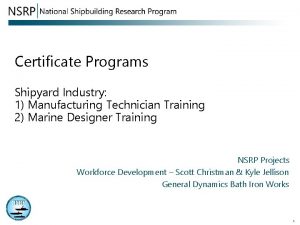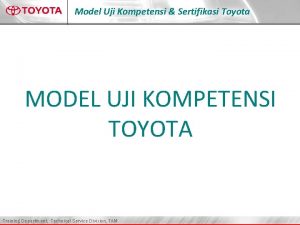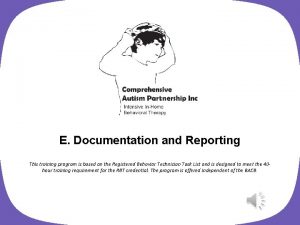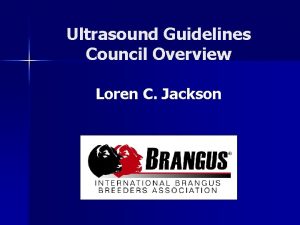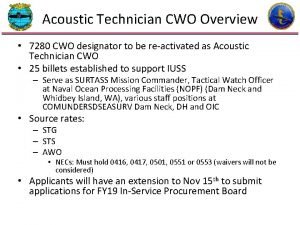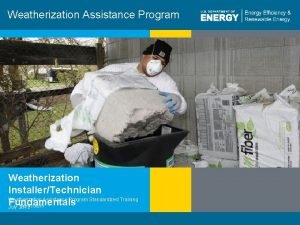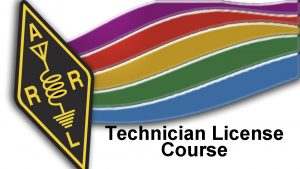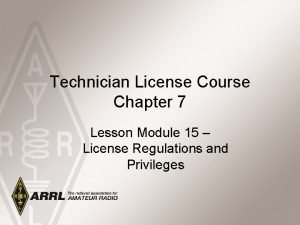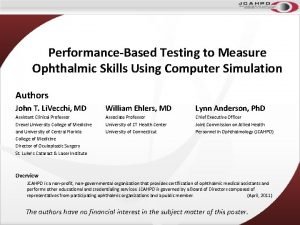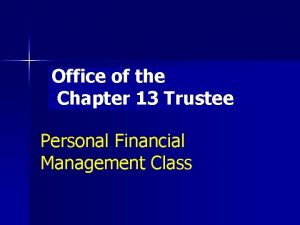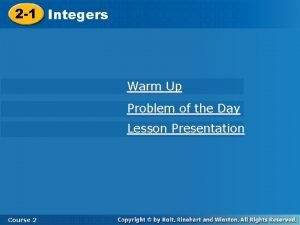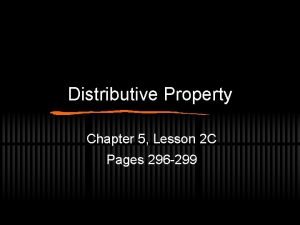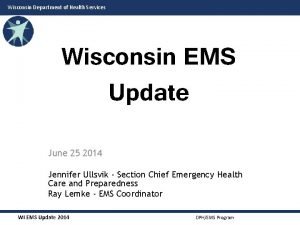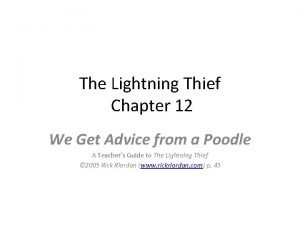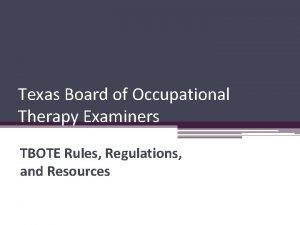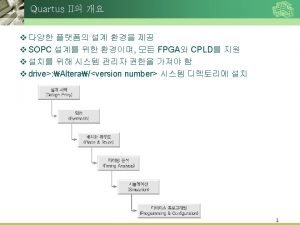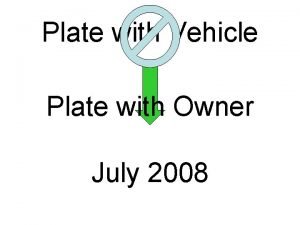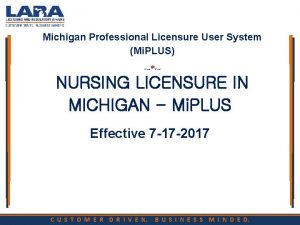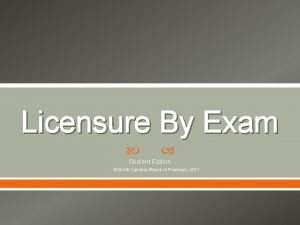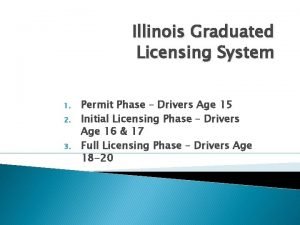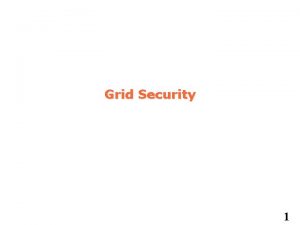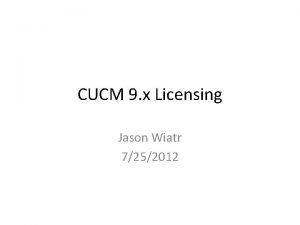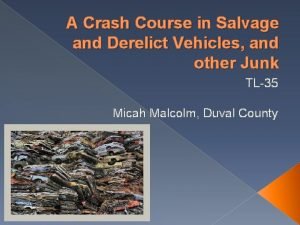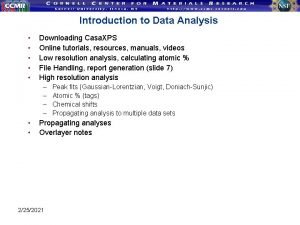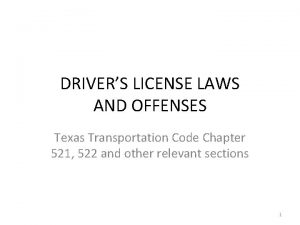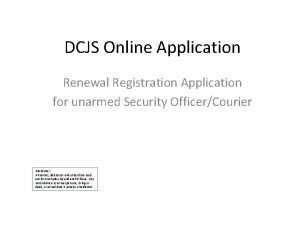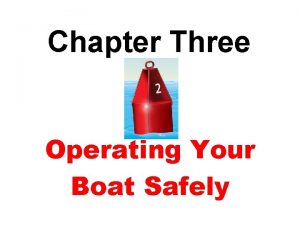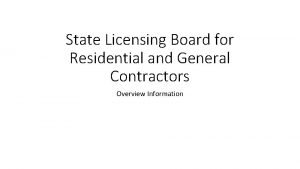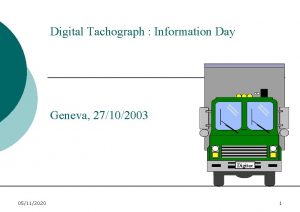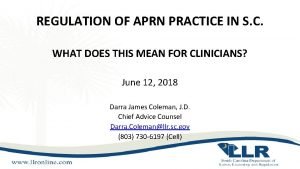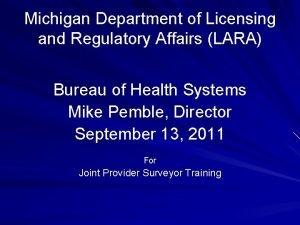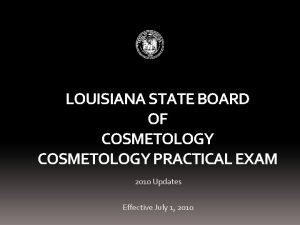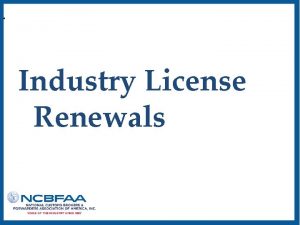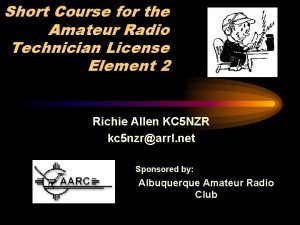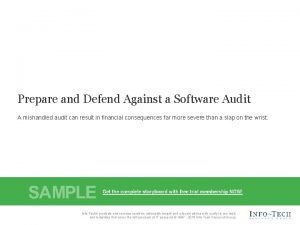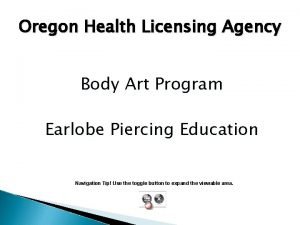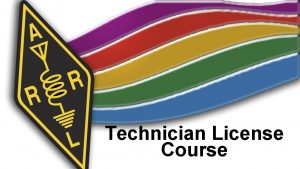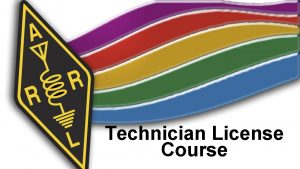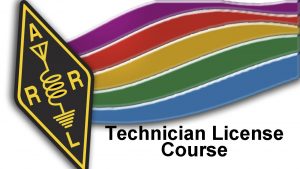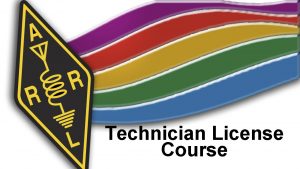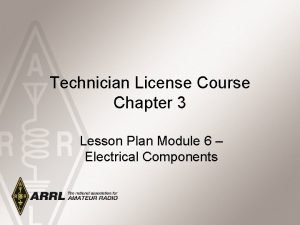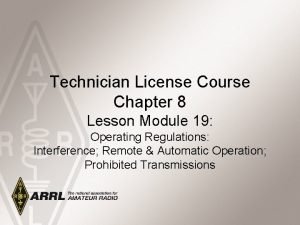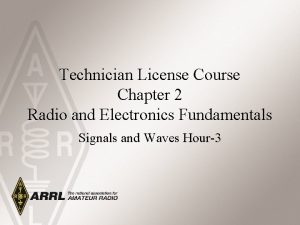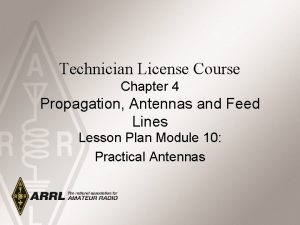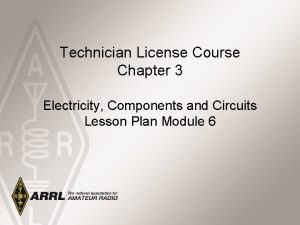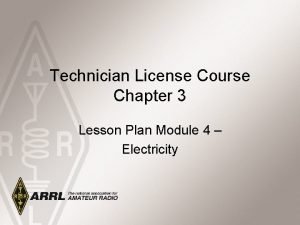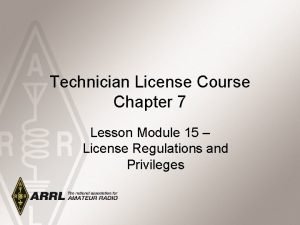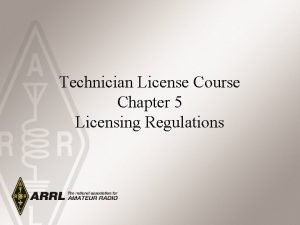Technician License Course Technician License Course Chapter 9






































































































































































- Slides: 166

Technician License Course

Technician License Course Chapter 9 Lesson Plan Module – 18 Safety & Amateur Radio

Electrical Injuries

Electrical Injuries • Shocks and burns.

Electrical Injuries • Shocks and burns. • Low voltages can cause enough current to create problems.

Electrical Injuries • Shocks and burns. • Low voltages can cause enough current to create problems. • Equipment today uses lower voltage than tube equipment but it can still cause burns.

Electrical Safety

Electrical Safety • Avoiding contact is the most effective way of practicing electrical safety

Electrical Safety • Avoiding contact is the most effective way of practicing electrical safety • Unplug equipment before working on it

Electrical Safety • Avoiding contact is the most effective way of practicing electrical safety • Unplug equipment before working on it • Keep one hand in your pocket

Electrical Safety • Avoiding contact is the most effective way of practicing electrical safety • Unplug equipment before working on it • Keep one hand in your pocket • Make sure equipment is grounded

Electrical Safety • Avoiding contact is the most effective way of practicing electrical safety • Unplug equipment before working on it • Keep one hand in your pocket • Make sure equipment is grounded • Use power from GFCI-protected circuits

Mitigating Electrical Hazards

Mitigating Electrical Hazards • If working on live equipment is required:

Mitigating Electrical Hazards • If working on live equipment is required: • Remove jewelry

Mitigating Electrical Hazards • If working on live equipment is required: • Remove jewelry • Avoid unintentional touching of circuitry

Mitigating Electrical Hazards • If working on live equipment is required: • Remove jewelry • Avoid unintentional touching of circuitry • Never bypass safety interlocks

Mitigating Electrical Hazards • If working on live equipment is required: • Remove jewelry • Avoid unintentional touching of circuitry • Never bypass safety interlocks • Discharge high-voltage points and components to ground

Mitigating Electrical Hazards • If working on live equipment is required: • Remove jewelry • Avoid unintentional touching of circuitry • Never bypass safety interlocks • Discharge high-voltage points and components to ground • Capacitors can store charge after power is off

Mitigating Electrical Hazards • If working on live equipment is required: • Remove jewelry • Avoid unintentional touching of circuitry • Never bypass safety interlocks • Discharge high-voltage points and components to ground • Capacitors can store charge after power is off • Storage batteries are dangerous when shorted

Responding to Electrical Injury

Responding to Electrical Injury • REMOVE POWER!

Responding to Electrical Injury • REMOVE POWER! • Have ON/OFF switches and circuit breakers clearly marked.

Responding to Electrical Injury • REMOVE POWER! • Have ON/OFF switches and circuit breakers clearly marked. • Install an emergency master power switch and make sure your family knows how to use it.

Responding to Electrical Injury • REMOVE POWER! • Have ON/OFF switches and circuit breakers clearly marked. • Install an emergency master power switch and make sure your family knows how to use it. • Call for help.

Responding to Electrical Injury • REMOVE POWER! • Have ON/OFF switches and circuit breakers clearly marked. • Install an emergency master power switch and make sure your family knows how to use it. • Call for help. • Learn CPR and first aid.

Electrical Grounding and Circuit Protection

Electrical Grounding and Circuit Protection • Make sure your station wiring meets code

Electrical Grounding and Circuit Protection • Make sure your station wiring meets code • Most ham equipment does not require special wiring or circuits

Electrical Grounding and Circuit Protection • Make sure your station wiring meets code • Most ham equipment does not require special wiring or circuits –Use 3 -wire power cords

Electrical Grounding and Circuit Protection • Make sure your station wiring meets code • Most ham equipment does not require special wiring or circuits –Use 3 -wire power cords –Use circuit breakers, circuit breaker outlets, or Ground Fault Circuit Interrupter (GFCI) circuit breakers or outlets

Electrical Grounding and Circuit Protection • Make sure your station wiring meets code • Most ham equipment does not require special wiring or circuits –Use 3 -wire power cords –Use circuit breakers, circuit breaker outlets, or Ground Fault Circuit Interrupter (GFCI) circuit breakers or outlets –Use proper fuse or circuit breaker size

Electrical Grounding and Circuit Protection • Make sure your station wiring meets code • Most ham equipment does not require special wiring or circuits –Use 3 -wire power cords –Use circuit breakers, circuit breaker outlets, or Ground Fault Circuit Interrupter (GFCI) circuit breakers or outlets –Use proper fuse or circuit breaker size –Don’t overload single outlets or circuits

Grounding & Bonding at RF

Grounding & Bonding at RF • RF burns from “hot spots” at high RF voltage

Grounding & Bonding at RF • RF burns from “hot spots” at high RF voltage • Do not cause serious injury at ham power level

Grounding & Bonding at RF • RF burns from “hot spots” at high RF voltage • Do not cause serious injury at ham power level • Prevent by bonding (connecting) equipment together with heavy wire or strap – braided strap not recommended at RF

Grounding & Bonding at RF • RF burns from “hot spots” at high RF voltage • Do not cause serious injury at ham power level • Prevent by bonding (connecting) equipment together with heavy wire or strap – braided strap not recommended at RF • Prevent by keeping people away from antennas and radial or counterpoise wires

Grounding & Bonding at RF • RF burns from “hot spots” at high RF voltage • Do not cause serious injury at ham power level • Prevent by bonding (connecting) equipment together with heavy wire or strap – braided strap not recommended at RF • Prevent by keeping people away from antennas and radial or counterpoise wires • Ground equipment for AC safety

Lightning Protection

Lightning Protection • Ground antennas and towers to local code

Lightning Protection • Ground antennas and towers to local code • Use 8 -ft ground rod for each tower leg

Lightning Protection • Ground antennas and towers to local code • Use 8 -ft ground rod for each tower leg • Bond rods to tower leg and the other rods

Lightning Protection • Ground antennas and towers to local code • Use 8 -ft ground rod for each tower leg • Bond rods to tower leg and the other rods • Ground connections should be as short as possible

Lightning Protection • Ground antennas and towers to local code • Use 8 -ft ground rod for each tower leg • Bond rods to tower leg and the other rods • Ground connections should be as short as possible • Use lightning arrestors on a single ground plate where cables enter the house

Lightning Protection • Ground antennas and towers to local code • Use 8 -ft ground rod for each tower leg • Bond rods to tower leg and the other rods • Ground connections should be as short as possible • Use lightning arrestors on a single ground plate where cables enter the house • Unplug and disconnect equipment (including telephones and computers) and feed lines if lightning is expected

RF Exposure

RF Exposure • Electromagnetic radiation (EMR) is not the same as radioactivity – much lower energy

RF Exposure • Electromagnetic radiation (EMR) is not the same as radioactivity – much lower energy • RF energy heats body tissues

RF Exposure • Electromagnetic radiation (EMR) is not the same as radioactivity – much lower energy • RF energy heats body tissues –Heating depends on the RF intensity and frequency.

RF Exposure • Electromagnetic radiation (EMR) is not the same as radioactivity – much lower energy • RF energy heats body tissues –Heating depends on the RF intensity and frequency. –If precautions are taken, RF exposure is minimal and not dangerous.

RF Intensity

RF Intensity • Power Density

RF Intensity • Power Density • Watts per square centimeter (w/cm 2)

RF Intensity • Power Density • Watts per square centimeter (w/cm 2) • Higher power density means higher RF exposure

RF Intensity • Power Density • Watts per square centimeter (w/cm 2) • Higher power density means higher RF exposure • RF absorption varies with frequency because of body part size

RF Intensity • Power Density • Watts per square centimeter (w/cm 2) • Higher power density means higher RF exposure • RF absorption varies with frequency because of body part size • Safe exposure levels have been established by the FCC

Maximum Permissible Exposure (MPE)

RF Environment

RF Environment • Controlled Environment.

RF Environment • Controlled Environment. –You know where people are standing in relation to your antenna and you can do something about it.

RF Environment • Controlled Environment. –You know where people are standing in relation to your antenna and you can do something about it. –Higher power density is allowed because you can make adjustments if needed.

RF Environment • Uncontrolled Environment. –You have no control of people near your antenna.

RF Environment • Uncontrolled Environment. –You have no control of people near your antenna. –Lower power density is allowed because you cannot control or adjust the exposure of people.

Duty Cycle and Duty Factor

Duty Cycle and Duty Factor • Duty cycle is the percentage of time that a transmitter is on during the evaluation period, from 0 to 100%

Duty Cycle and Duty Factor • Duty cycle is the percentage of time that a transmitter is on during the evaluation period, from 0 to 100% • Duty cycle = 100 x (time on / total time)

Duty Cycle and Duty Factor • Duty cycle is the percentage of time that a transmitter is on during the evaluation period, from 0 to 100% • Duty cycle = 100 x (time on / total time) • Duty factor is the same as duty cycle, but given as a number from 0 to 1. 0

Duty Cycle and Duty Factor • Duty cycle is the percentage of time that a transmitter is on during the evaluation period, from 0 to 100% • Duty cycle = 100 x (time on / total time) • Duty factor is the same as duty cycle, but given as a number from 0 to 1. 0 • Higher duty cycle or factor means higher average power density and exposure

Mode Duty Cycle

Mode Duty Cycle • Accounts for the different characteristics of the transmitted signal’s waveform

RF Exposure Evaluation

RF Exposure Evaluation • All fixed stations must perform an exposure evaluation.

RF Exposure Evaluation • All fixed stations must perform an exposure evaluation. • Use online calculator (easiest)

RF Exposure Evaluation • All fixed stations must perform an exposure evaluation. • Use online calculator (easiest) • Model exposure with software (difficult)

RF Exposure Evaluation • All fixed stations must perform an exposure evaluation. • Use online calculator (easiest) • Model exposure with software (difficult) • Measure RF power density (most difficult)

RF Exposure Evaluation • At lower power levels, no evaluation is required. Varies with frequency – example: below 50 W at VHF.

RF Exposure Evaluation • At lower power levels, no evaluation is required. Varies with frequency – example: below 50 W at VHF. • Re-evaluate exposure when station equipment or operating frequencies change.

Reducing RF Exposure

Reducing RF Exposure • Relocate or reorient antennas

Reducing RF Exposure • Relocate or reorient antennas • Raise the antenna

Reducing RF Exposure • Relocate or reorient antennas • Raise the antenna • Reduce antenna gain

Reducing RF Exposure • Relocate or reorient antennas • Raise the antenna • Reduce antenna gain • Reduce RF power output

Reducing RF Exposure • Relocate or reorient antennas • Raise the antenna • Reduce antenna gain • Reduce RF power output • Change to a lower duty cycle mode

Mobile Safety

Mobile Safety • Mobile Installations

Mobile Safety • Mobile Installations • Secure all equipment

Mobile Safety • Mobile Installations • Secure all equipment • Place equipment where you can operate it safely while driving

Mobile Safety • Mobile Installations • Secure all equipment • Place equipment where you can operate it safely while driving • Know local rules for use of communications equipment while driving

Mobile Safety • Mobile Installations • Secure all equipment • Place equipment where you can operate it safely while driving • Know local rules for use of communications equipment while driving • May need hands-free microphone

Power Line Safety

Power Line Safety • Keep antennas well away from power lines

Power Line Safety • Keep antennas well away from power lines • Check for power lines before installing antennas in trees

Power Line Safety • Keep antennas well away from power lines • Check for power lines before installing antennas in trees • Provide a minimum of 10 feet of clearance if antenna falls

Power Line Safety • Keep antennas well away from power lines • Check for power lines before installing antennas in trees • Provide a minimum of 10 feet of clearance if antenna falls • Never attach antennas or guy lines to utility poles or structures

Tower Work

Tower Work • Basic tower safety

Tower Work • Basic tower safety –Proper clothing, hard hat and eye protection

Tower Work • Basic tower safety –Proper clothing, hard hat and eye protection –Use a proper climbing harness, not a lineman’s belt or rock-climbing gear

Tower Work • Basic tower safety –Proper clothing, hard hat and eye protection –Use a proper climbing harness, not a lineman’s belt or rock-climbing gear –Don’t climb a crank-up tower supported only by its lift cable – block and secure it first

Tower Work • Basic tower safety –Proper clothing, hard hat and eye protection –Use a proper climbing harness, not a lineman’s belt or rock-climbing gear –Don’t climb a crank-up tower supported only by its lift cable – block and secure it first –Use a gin pole to lift heavy items

Tower Work • Basic tower safety –Proper clothing, hard hat and eye protection –Use a proper climbing harness, not a lineman’s belt or rock-climbing gear –Don’t climb a crank-up tower supported only by its lift cable – block and secure it first –Use a gin pole to lift heavy items –Don’t work alone – use a ground crew

Practice Questions

What is a safety hazard of a 12 voltage storage battery?

What is a safety hazard of a 12 voltage storage battery? Shorting the terminals can cause burns, fire, or an explosion

How does current flowing through the body cause a health hazard?

How does current flowing through the body cause a health hazard? By heating tissue It disrupts the electrical functions of cells It causes involuntary muscle contractions

What is connected to the green wire in a three-wire electrical AC plug?

What is connected to the green wire in a three-wire electrical AC plug? Safety ground

What is a good way to guard against electrical shock at your station?

What is a good way to guard against electrical shock at your station? Use three-wire cords and plugs for all AC powered equipment Connect all AC powered station equipment to a common safety ground Use a circuit protected by a ground-fault interrupter

What precaution should be taken when installing devices for lightning protection in a coaxial cable feed line?

What precaution should be taken when installing devices for lightning protection in a coaxial cable feed line? Ground all of the protectors to a common plate which is in turn connected to an external ground

What safety equipment should always be included in home-built equipment that is powered from 120 V AC power circuits?

What safety equipment should always be included in home-built equipment that is powered from 120 V AC power circuits? A fuse or circuit breaker in series with the AC "hot" conductor

What kind of hazard might exist in a power supply when it is turned off and disconnected?

What kind of hazard might exist in a power supply when it is turned off and disconnected? You might receive an electric shock from the charged stored in large capacitors

When should members of a tower work team wear a hard hat and safety glasses?

When should members of a tower work team wear a hard hat and safety glasses? At all times when any work is being done on the tower

What is a good precaution to observe before climbing an antenna tower?

What is a good precaution to observe before climbing an antenna tower? Put on a climbing harness and safety glasses

Under what circumstances is it safe to climb a tower without a helper or observer?

Under what circumstances is it safe to climb a tower without a helper or observer? Never

What is an important safety precaution to observe when putting up an antenna tower?

What is an important safety precaution to observe when putting up an antenna tower? Look for and stay clear of any overhead electrical wires

What is the purpose of a gin pole?

What is the purpose of a gin pole? To lift tower sections or antennas

What is the minimum safe distance from a power line to allow when installing an antenna?

What is the minimum safe distance from a power line to allow when installing an antenna? So that if the antenna falls unexpectedly, no part of it can come closer than 10 feet to the power wires

What is an important safety rule to remember when using a crank-up tower?

What is an important safety rule to remember when using a crank-up tower? This type of tower must never be climbed unless it is in the fully retracted position

What is considered to be a proper grounding method for a tower?

What is considered to be a proper grounding method for a tower? Separate eight-foot long ground rods for each tower leg, bonded to the tower and each other

Why should you avoid attaching an antenna to a utility pole?

Why should you avoid attaching an antenna to a utility pole? The antenna could contact high-voltage power wires

What is true concerning grounding conductors used for lightning protection?

What is true concerning grounding conductors used for lightning protection? Sharp bends must be avoided

What establishes grounding requirements for an amateur radio tower or antenna?

What establishes grounding requirements for an amateur radio tower or antenna? Local electrical codes

What is good practice when installing ground wires on a tower for lightning protection?

What is good practice when installing ground wires on a tower for lightning protection? Ensure that connections are short and direct

What type of radiation are VHF and UHF radio signals?

What type of radiation are VHF and UHF radio signals? Non-ionizing radiation

What is the maximum power level that an amateur radio station may use at VHF frequencies before an RF exposure evaluation is required?

What is the maximum power level that an amateur radio station may use at VHF frequencies before an RF exposure evaluation is required? 50 watts PEP at the antenna

What factors affect the RF exposure of people near an amateur station antenna?

What factors affect the RF exposure of people near an amateur station antenna? Frequency and power level of the RF field Distance from the antenna to a person Radiation pattern of the antenna

Why do exposure limits vary with frequency?

Why do exposure limits vary with frequency? The human body absorbs more RF energy at some frequencies than at others

What is an acceptable method to determine that your station complies with FCC RF exposure regulations?

What is an acceptable method to determine that your station complies with FCC RF exposure regulations? By calculation based on FCC OET Bulletin 65 By calculation based on computer modeling By measurement of field strength using calibrated equipment

What could happen if a person accidentally touched your antenna while you were transmitting?

What could happen if a person accidentally touched your antenna while you were transmitting? They might receive a painful RF burn

What actions might amateur operators take to prevent exposure to RF radiation in excess of FCC-supplied limits?

What actions might amateur operators take to prevent exposure to RF radiation in excess of FCC-supplied limits? Relocate antennas

How can you make sure your station stays in compliance with RF safety regulations?

How can you make sure your station stays in compliance with RF safety regulations? By re-evaluating the station whenever an item of equipment is changed

Why is duty cycle one of the factors used to determine safe RF radiation exposure levels?

Why is duty cycle one of the factors used to determine safe RF radiation exposure levels? It affects the average exposure of people to radiation

What is the definition of duty cycle during the averaging time for RF exposure?

What is the definition of duty cycle during the averaging time for RF exposure? The percentage of time that a transmitter is transmitting

How does RF radiation differ from ionizing radiation (radioactivity)?

How does RF radiation differ from ionizing radiation (radioactivity)? RF radiation does not have sufficient energy to cause genetic damage

If the averaging time for exposure is 6 minutes, how much power density is permitted if the signal is present for 3 minutes and absent for 3 minutes rather than being present for the entire 6 minutes?

If the averaging time for exposure is 6 minutes, how much power density is permitted if the signal is present for 3 minutes and absent for 3 minutes rather than being present for the entire 6 minutes? 2 times as much

End of Module 18
 Manufacturing technician license
Manufacturing technician license Manufacturing tech license
Manufacturing tech license English bond t junction
English bond t junction Course number and title
Course number and title Course interne moyenne externe
Course interne moyenne externe Getting a drivers license illegally may result in
Getting a drivers license illegally may result in Chapter 1 nj driver license system
Chapter 1 nj driver license system Chapter 1 the new jersey driver license system answers
Chapter 1 the new jersey driver license system answers When preparing an iv solution a technician should work
When preparing an iv solution a technician should work How long must a technician evacuating refrigerant
How long must a technician evacuating refrigerant Pros and cons of being a veterinary technician
Pros and cons of being a veterinary technician Maximo assignment manager
Maximo assignment manager Calibration technician training
Calibration technician training Jobs in health science career cluster
Jobs in health science career cluster Radar and sonar technician career cluster
Radar and sonar technician career cluster Technician a says that the bulb trade number
Technician a says that the bulb trade number Toyota technician certification
Toyota technician certification Mobile technician app
Mobile technician app Mtm pharmacy technician
Mtm pharmacy technician Maximo scheduling
Maximo scheduling Sample aba session notes
Sample aba session notes Surface repair technician training
Surface repair technician training She technician apprenticeship
She technician apprenticeship Vetenarian technician
Vetenarian technician Live technician
Live technician Carcass ultrasound technician training
Carcass ultrasound technician training Bcs coding and logic exam
Bcs coding and logic exam A csi lab technician _____.
A csi lab technician _____. Horticultural technician apprentice
Horticultural technician apprentice Acoustic technician
Acoustic technician Shane palmer concreting
Shane palmer concreting How to become a weatherization technician
How to become a weatherization technician Level 9 technician
Level 9 technician Technician class privileges
Technician class privileges Tracemp
Tracemp Pci wind turbine technician
Pci wind turbine technician Pharmacy technician george brown
Pharmacy technician george brown Cot skills simulator
Cot skills simulator Sae standard for hoist location
Sae standard for hoist location Ecc x ray technician
Ecc x ray technician Dtabc
Dtabc Course 2 chapter 1 ratios and proportional reasoning
Course 2 chapter 1 ratios and proportional reasoning Steve wyborney splat
Steve wyborney splat Chapter 13 personal financial management course
Chapter 13 personal financial management course Course 2 chapter 3 integers
Course 2 chapter 3 integers 9(3+c+4) distributive property
9(3+c+4) distributive property Www.stevewyborney.com splat
Www.stevewyborney.com splat Work based learning license mn
Work based learning license mn Wi ems elicensing
Wi ems elicensing License smart register idtoken invalid input
License smart register idtoken invalid input What happened in chapter 12 percy jackson
What happened in chapter 12 percy jackson Ga coam
Ga coam Tbote rules
Tbote rules Ingram micro spla
Ingram micro spla Quartus web edition download
Quartus web edition download Govcg
Govcg South dakota temporary license plates
South dakota temporary license plates Oregon state board of nursing
Oregon state board of nursing Omma monthly report
Omma monthly report Basic driver's license nj
Basic driver's license nj Graduated drivers license nj
Graduated drivers license nj Sap license negotiation
Sap license negotiation Ncdmv license and theft bureau
Ncdmv license and theft bureau Www.michigan/miplus
Www.michigan/miplus Ncbop renewal
Ncbop renewal Ptal california medical board
Ptal california medical board Kofax clarity
Kofax clarity Kentucky board of nursing renewal
Kentucky board of nursing renewal Taxi license finland
Taxi license finland Sas license cost
Sas license cost Graduated license illinois
Graduated license illinois Hid bluetooth credentials
Hid bluetooth credentials Pesticide warning signs ontario
Pesticide warning signs ontario Emd license
Emd license Rok vs oem
Rok vs oem John doe drivers license
John doe drivers license Dcas license how to apply
Dcas license how to apply Dmc online registration
Dmc online registration Cucm enhanced license
Cucm enhanced license Cots license
Cots license Bc gaming license
Bc gaming license Specialty cottage indoor license
Specialty cottage indoor license Kbn nursing license
Kbn nursing license Derelict vehicle certificate
Derelict vehicle certificate Virginia abc license renewal
Virginia abc license renewal Indiana teacher certification practice test
Indiana teacher certification practice test Scapi_ope.dll
Scapi_ope.dll Odc license consultants
Odc license consultants Qlikview license
Qlikview license Microsoft services provider license agreement
Microsoft services provider license agreement License
License Pmp aware nm
Pmp aware nm Limited lawn and ornamental license florida
Limited lawn and ornamental license florida Snapshot standby database license
Snapshot standby database license Campus-wide license
Campus-wide license Newport beach business license
Newport beach business license New mexico interlock license
New mexico interlock license Railway board's letter no.2005/lml/18/8
Railway board's letter no.2005/lml/18/8 Show license udi
Show license udi Casaxps tutorial
Casaxps tutorial Interior decorating license
Interior decorating license Ayush license karnataka
Ayush license karnataka Forestry licence viewer
Forestry licence viewer Registration system for federal motor vehicles
Registration system for federal motor vehicles Microsoft executive summary
Microsoft executive summary Restriction codes in texas
Restriction codes in texas Dfs make a payment
Dfs make a payment Dcjs renewal
Dcjs renewal Ct p2 continuing education
Ct p2 continuing education Key west transient license
Key west transient license Boat license missouri
Boat license missouri 201 kar 20:057
201 kar 20:057 Federal government license plates
Federal government license plates Coam license for sale
Coam license for sale Texas state guard maritime regiment
Texas state guard maritime regiment Conclusion of stem cells
Conclusion of stem cells Georgia contractors license qualifying agent
Georgia contractors license qualifying agent Spectragryph license key
Spectragryph license key Creative commons license
Creative commons license Images with creative commons license
Images with creative commons license Nhp site license
Nhp site license Involuntary inactive real estate license florida
Involuntary inactive real estate license florida Efficient elements powerpoint
Efficient elements powerpoint Smart tachograph license missing vdo
Smart tachograph license missing vdo K-cdl intrastate only michigan
K-cdl intrastate only michigan Comsol fnl
Comsol fnl American enterprise institute
American enterprise institute Yakama nation sex offender registry
Yakama nation sex offender registry Creative commons license
Creative commons license Sc aprn license
Sc aprn license Qlikview sap connector
Qlikview sap connector License
License Proof of residency ga
Proof of residency ga Michigan department of licensing and regulation
Michigan department of licensing and regulation Louisiana cosmetologist license
Louisiana cosmetologist license Nagios log server demo
Nagios log server demo Creative commons license
Creative commons license Kepware license activation
Kepware license activation Nvocc license application
Nvocc license application Parwana license online
Parwana license online Alabama driving manual
Alabama driving manual Driver license class
Driver license class Beftn vs npsb
Beftn vs npsb When did the initial gdl law become effective in alabama?
When did the initial gdl law become effective in alabama? Wisconsin sales tax license
Wisconsin sales tax license Websax
Websax License
License Defend from license audits
Defend from license audits Wisconsin pesticide applicator license
Wisconsin pesticide applicator license Parse tree definition
Parse tree definition Horizontal license nj
Horizontal license nj Md dental board
Md dental board Lmtools.exe
Lmtools.exe Kentucky board of nursing application
Kentucky board of nursing application Bccnp provisional license
Bccnp provisional license Indiana disabled veterans license plates
Indiana disabled veterans license plates Ilmt pvu table
Ilmt pvu table Nhp site license
Nhp site license Georgia pe pdh
Georgia pe pdh Class c license
Class c license Yamm license
Yamm license Osbn license
Osbn license Palo alto enterprise license agreement
Palo alto enterprise license agreement Dhec home care license
Dhec home care license Rspo trademark license
Rspo trademark license Oregon health licensing agency
Oregon health licensing agency Sharding oracle
Sharding oracle
